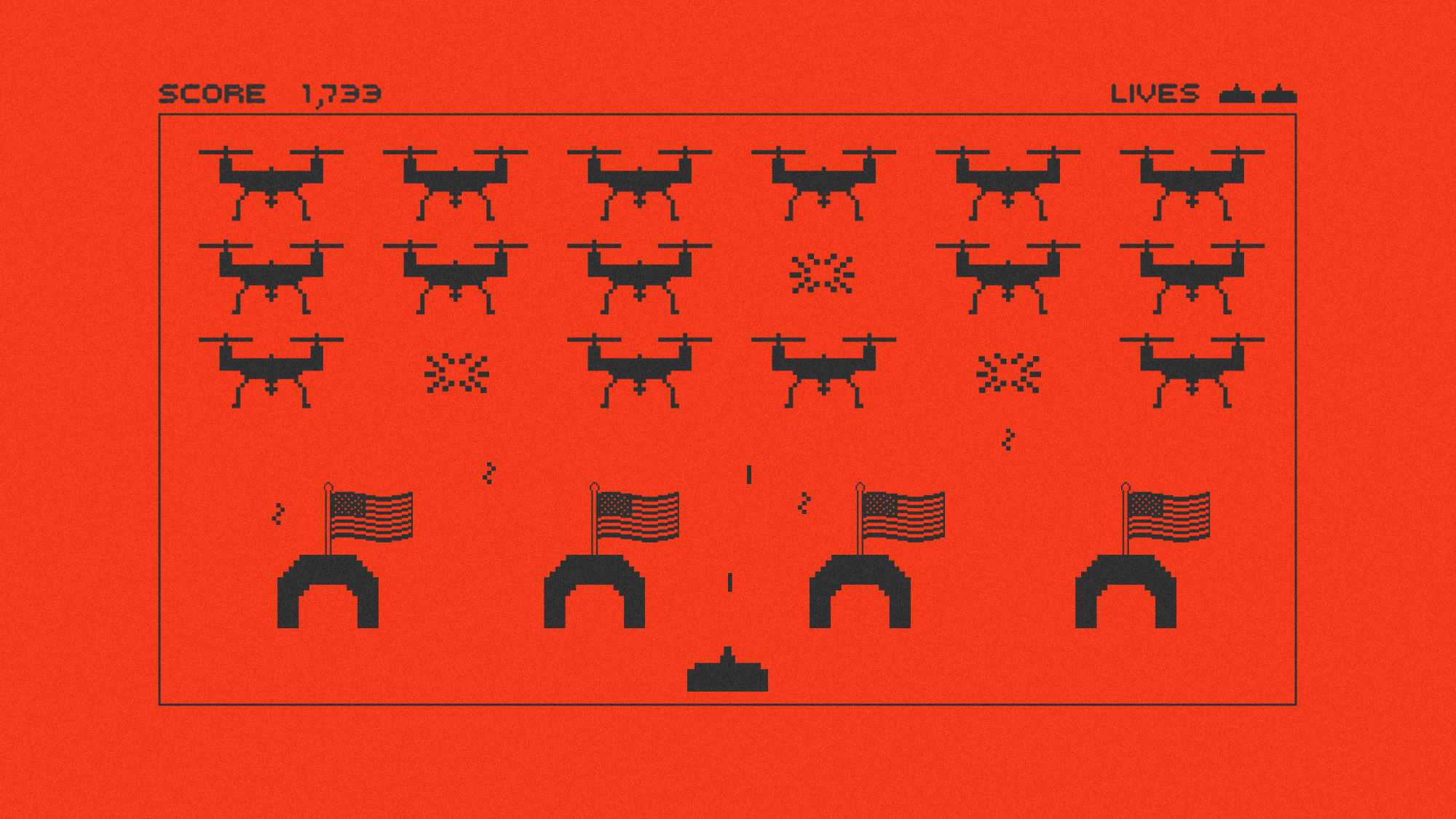Is the next cold war a drone-swarm race between US and China?
Both global superpowers are building up their capacity for surging robotic warfare. What happens next is anyone's guess.


The latter half of the 20th century was largely defined by a seething Cold War between the United States and what was then the Soviet Union over which global superpower's influence and agenda would ultimately reign supreme. Ostensibly, that conflict was one of ideologies and politics. In practice, however, it was as much about which nation had the more impressive stockpile of atomic weapons as it was about making the case for capitalism or communism.
Now, at the start of the 21st century, the United States is locked in what some observers have already described as a new cold war. It's again ostensibly between American capitalism and a communist superpower, but this time an ascendent China is seeking to exert its sway over Asia and beyond. Like its predecessor, this cold war includes military buildup intended to both intimidate and dominate should things heat up. But while the U.S. and Russia spent much of the Cold War perfecting their capacities for large-scale nuclear destruction, advances in robotics and computing have allowed tacticians to think smaller. Now, planners for both militaries are "gearing up for a new kind of warfare in which squadrons of air and sea drones equipped with artificial intelligence work together like a swarm of bees to overwhelm an enemy," each doing different tasks but operating as a whole, The Associated Press said.
What does an arms race focused on fleets of robots rather than the fusion of atoms look like, and where might it lead the United States, China, and the rest of the world?
The Week
Escape your echo chamber. Get the facts behind the news, plus analysis from multiple perspectives.

Sign up for The Week's Free Newsletters
From our morning news briefing to a weekly Good News Newsletter, get the best of The Week delivered directly to your inbox.
From our morning news briefing to a weekly Good News Newsletter, get the best of The Week delivered directly to your inbox.
What did the commentators say?
All eyes are on Taiwan for now, with the Pentagon "quietly experimenting in the Pacific with a lethal drone concept called 'hellscape'" intended to "disrupt an amphibious invasion of Taiwan with a combination of loitering munitions and lethal attack drones," the U.S. Naval Institute said. Those experiments appear to be part of a military project dubbed "Replicator" that will feature "thousands of attritable, autonomous systems [deployed] across multiple domains within the next two years as part of a new initiative to better compete with China," Defense News said.
In part, the push for drone swarm supremacy comes down to cost. As a 2023 solicitation document from the Strategic Technology Office of the Defense Advanced Research Projects Agency explains, one of the military's hopes for autonomous drone projects is that "low-cost swarms with diverse sensors and kinetic and non-kinetic effectors would primarily be pre-positioned forward and launched remotely, providing rapid response, and adaptability to overcome the adversary's time-distance-mass advantage." It's something "many warfighters have long advocated," Bloomberg said, calling it a shift away from "huge, expensive, vulnerable platforms" like aircraft carriers toward something "lighter, cheaper, [and] more nimble." Replicator is designed to counter China's advantage of "more ships, more missiles, more people," Deputy Defense Secretary Kathleen Hicks explained at a conference this summer, adding that "we'll counter the [People's Liberation Army's] mass with mass of our own, but ours will be harder to plan for, harder to hit, and harder to beat."
What next?
Barring any major leaps in the technology involved, experts who spoke to the AP predicted it would take around five years before fully autonomous drone fleets will be deployed in earnest. Although "the Chinese have an edge in hardware right now," Adam Bry, CEO of drone manufacturer Skydio, told the outlet, "I think we have an edge in software." Still, because drone swarm warfare is predicated so heavily on software, there is a fear that China might "offer swarm technology to U.S. foes or repressive countries," or other nations further behind in this arms race could eventually share the software in the future.
For now, the basics of drone warfare "already exist," The Wall Street Journal said, "whether they're the Shahed drones attacking shipping in the Gulf of Aden or the Switchblade drones destroying Russian tanks in the Donbas or smart seaborne mines around Taiwan." The real revolution will come when AI systems can direct fleets of drones at scale, at which point the nature of future warfare will be "brain-on-brain conflict."
A free daily email with the biggest news stories of the day – and the best features from TheWeek.com
Ultimately, as The Debrief said, the "use of militarized autonomous technologies is likely no longer a question of 'if' but a certainty of 'when.'"
Rafi Schwartz has worked as a politics writer at The Week since 2022, where he covers elections, Congress and the White House. He was previously a contributing writer with Mic focusing largely on politics, a senior writer with Splinter News, a staff writer for Fusion's news lab, and the managing editor of Heeb Magazine, a Jewish life and culture publication. Rafi's work has appeared in Rolling Stone, GOOD and The Forward, among others.
-
 The best homes of the year
The best homes of the yearFeature Featuring a former helicopter engine repair workshop in Washington, D.C. and high-rise living in San Francisco
-
 Critics’ choice: The year’s top 10 movies
Critics’ choice: The year’s top 10 moviesFeature ‘One Battle After Another’ and ‘It Was Just an Accident’ stand out
-
 The small Caribbean island courting crypto billions
The small Caribbean island courting crypto billionsUnder the Radar Crypto mogul Olivier Janssens plans to create a libertarian utopia on Nevis
-
 Why does Trump want to reclassify marijuana?
Why does Trump want to reclassify marijuana?Today's Big Question Nearly two-thirds of Americans want legalization
-
 Why does White House Chief of Staff Susie Wiles have MAGA in a panic?
Why does White House Chief of Staff Susie Wiles have MAGA in a panic?TODAY’S BIG QUESTION Trump’s all-powerful gatekeeper is at the center of a MAGA firestorm that could shift the trajectory of the administration
-
 Is MAGA melting down?
Is MAGA melting down?Today's Big Question Candace Owens, Tucker Carlson, Laura Loomer and more are feuding
-
 Trump wants to build out AI with a new ‘Tech Force’
Trump wants to build out AI with a new ‘Tech Force’The Explainer The administration is looking to add roughly 1,000 jobs
-
 How cryptocurrency is changing politics
How cryptocurrency is changing politicsIn The Spotlight From electoral campaigns to government investments, crypto is everywhere and looks like it’s here to stay
-
 ‘Consistency at the ballot box isn’t nearly as meaningful to many voters here’
‘Consistency at the ballot box isn’t nearly as meaningful to many voters here’Instant Opinion Opinion, comment and editorials of the day
-
 Are Donald Trump’s peace deals unraveling?
Are Donald Trump’s peace deals unraveling?Today’s Big Question Violence flares where the president claimed success
-
 Will Trump’s $12 billion bailout solve the farm crisis?
Will Trump’s $12 billion bailout solve the farm crisis?Today’s Big Question Agriculture sector says it wants trade, not aid
